Where to Stay in Lisbon: A Complete Guide (for First Timers)
Lisbon was both our first stop in Portugal, and was also our last stop in Europe a couple of months later when our 89 days in Europe were up (that’s just shy of the 90 day maximum we can spend in the E.U. on a tourist visa).
We really enjoyed Lisbon on that first trip, and spent the better part of a week wandering the streets of Lisbon’s neighborhoods, stopping here and there for a cup of coffee or a glass of Portuguese wine – which is both cheap and delicious (the two best wine tasting notes, in our opinion).
Since then, Matt returned this past spring to revisit the Portuguese capital and was reminded why it has skyrocketed up many people’s lists of places to visit (we personally know at least ten people who have gone to Lisbon over the past few years).
Lisbon is a city not unlike San Francisco, our former home, in that each neighborhood has a distinct look, style, and overall vibe.
As you walk from the cosmopolitan grid that is Baixa, Lisbon’s downtown, towards the narrow, winding cobblestone streets in Alfama, the oldest-feeling part of the city, you’ll understand what we mean.
The areas are a few short blocks apart, but couldn’t look and feel more different.
Once you begin to know the history of Lisbon, you’ll start to understand why. We’re obviously not Lisbon history experts, but we did a couple of walking tours and connected with locals who are.
Our Drunk History (if you’re not familiar, it’s a tv show where they film someone simultaneously telling a story about a historical event and getting wasted at the same time – it’s really fun!) take on the reason that Lisbon’s neighborhoods look and feel so different is that, after the earthquake in the 18th Century, the city brought in various architects from different places around the world to help rebuild and replan the city.
As a result, you have parts of the city that look like Paris, with grand boulevards lined with four story apartment buildings, and parts of the city that feel like Ancient Rome, with cobblestone streets and castles.
In this guide, we’re going to use our experiences exploring the city to do our best to walk you through all the information you need to figure out where to stay in Lisbon for your particular style, budget, and preferences.
We’re going to give you four main neighborhoods we’d recommend, and why we recommend them.
Each area offers a different blend of vibes, prices, and pros and cons, and we’ll cover it all below so that you’re armed with all the information you need to figure out where to stay for your particular style and budget.
Our intention is that, by the end of this guide, you have everything you need to choose and book the right place to stay in Lisbon for you and your travel companions.
Sound good to you? Let’s get into it.
Important note: This is a long guide with lots of detail (it got longer and longer as we put it together), but we’ve done our best to structure it with headings, a helpful summary at the top, and a table of contents to help you navigate it without reading literally every word.

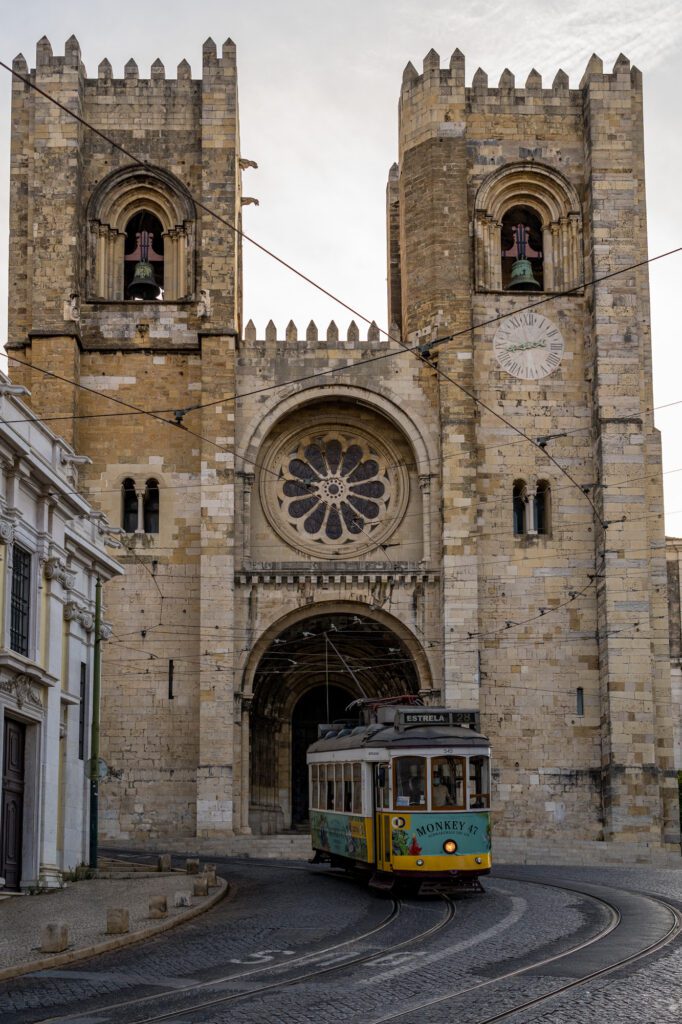

Disclaimer: Some of the links in this post, like hotel links, are affiliate links, meaning at no additional cost to you, we make a little bit of money if you click through and book. That being said, we would never recommend something to you that we don’t stand behind 100%.
Where to Stay in Lisbon: The 4 Best Areas (for First Timers)
Let’s get straight into it here, because we have a lot to cover.
Before we get too deep, we’re well aware that a few of you are currently ready to throw your left shoe at the screen, saying “I don’t have time to read all of that, JUST TELL ME THE BEST PLACE TO STAY!”
Well, here’s a quick summary of this guide if you’re short on time (though we’d recommend reading the section of the place you end up staying for tips and places to add to your list!).
There’s plenty more detail in the full guide below, if you’re so inclined.
Our overall recommendation is to stay in Chiado, which is a great combination of central location, charm, and places to eat and drink.
We loved this part of the city, and it’s basically the center point between all of our favorite neighborhoods in Lisbon.
Our friends stayed at the beautiful Casa do Barao, a gorgeous hotel in a perfect location (with a rooftop pool!).
If you’re looking for a more affordable stay, look at Feeling Chiado 15 or Chiado 44, two charming, mid-range guesthouses in the heart of Chiado.
If you want an apartment, my mom stayed at 54 São Paulo on a recent trip and raved about it.
If it’s a short trip and you want the most convenient location possible, stay at the base of Lisbon’s hills in Baixa (near Rossio Square).
It lacks the charm of the rest of the city (it’s very modern and well-planned, which isn’t the case for the hills), but the location is great for getting around (on foot or on public transit), and the prices are reasonable.
Our top hotel pick here is My Story Hotel Figueira, which is right on a beautiful square a few blocks from Rossio station (where you’ll catch the train for a day trip to Sintra).
We stayed at the Visionaire Apartments (which are around the corner from the hotel we mentioned above) on my last trip, and it was perfect – highly recommend (though I wouldn’t call them budget-friendly).
If you want to stay in the most romantic part of the city, you should stay in Alfama.
This part of the city is all narrow streets and excellent views out over the city. Plus, a few of our favorite spots to eat and drink are in the neighborhood (don’t miss Miss Can!).
It’s a pain to get to, though, since it’s on top of a big hill with limited transit options. The hotel options here are limited, and we’d opt for the Convento do Salvador for a unique stay in a former convent.
With that out of the way, a few notes before we get into specifics.
For each of the four neighborhoods we think you should consider, we’ve created a structure to help you figure out if it’s the right home base for you. Here’s what we’ll cover:
- An overview of the neighborhood and our experience with it. We’ve personally been to and explored (more than once) all of the areas on this list, so we’ll try to give you a little bit of our perspective on what makes each area special.
- Pros and cons of staying in this area. The things you need to know to make your decision.
- A collection of a few places to stay that stood out to us. Sometimes it’ll be because they have rooms with great views, sometimes it’s the rooftop pool, sometimes it’s that the hotel offers a great value given the location.
Where We’ve Stayed in Lisbon
The best place to start this guide is our own personal experience. We found ourselves in Lisbon three times in the past couple of years, and somehow we’ve always found ourselves staying in Baixa, which means that we’re often choosing convenience and utility over vibes and being in the middle of all the action.
Which, if you know us, definitely checks out.
There are two specific places we wanted to mention that either we have personally stayed at, or friends and family have stayed at and enjoyed.
I should note that I, Matt, have Celiac Disease, which means we need to eat strictly gluten free.
A place to stay with access to a kitchen is essentially a must-have for us, so we tend to gravitate towards apartments. Lisbon’s gluten free scene is fine – not great (here’s my gluten free guide to Lisbon) – but I did find myself cooking for myself fairly often on my last trip.
First, the Visionaire Apartments, which are right in the heart of Baixa on Praça da Figueira, which is approximately three minutes from Rossio Station and right in the middle of it all.
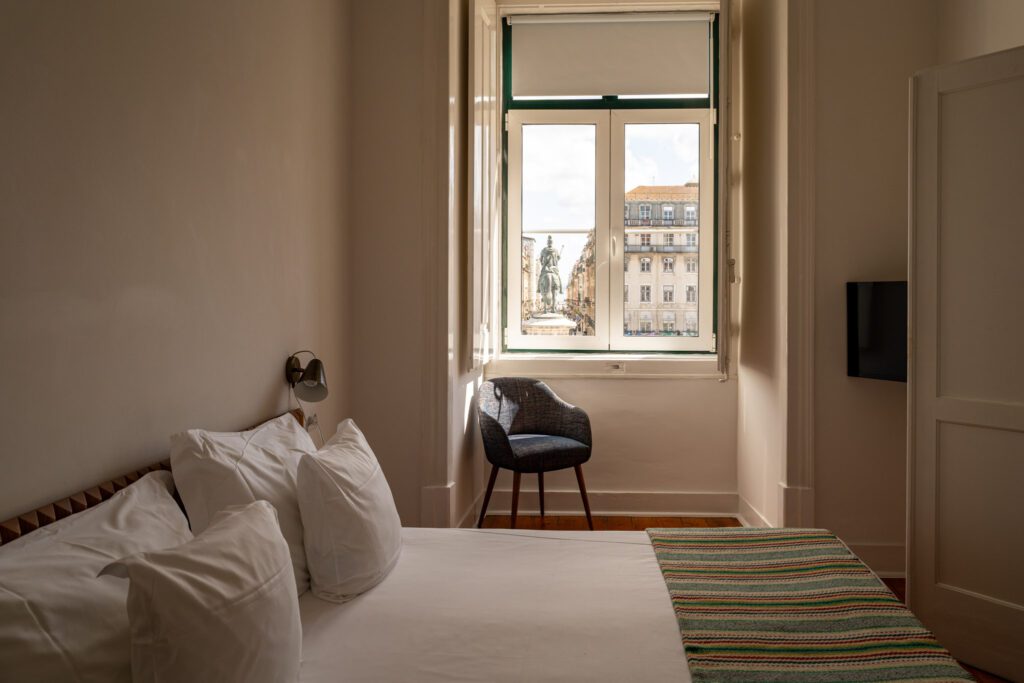
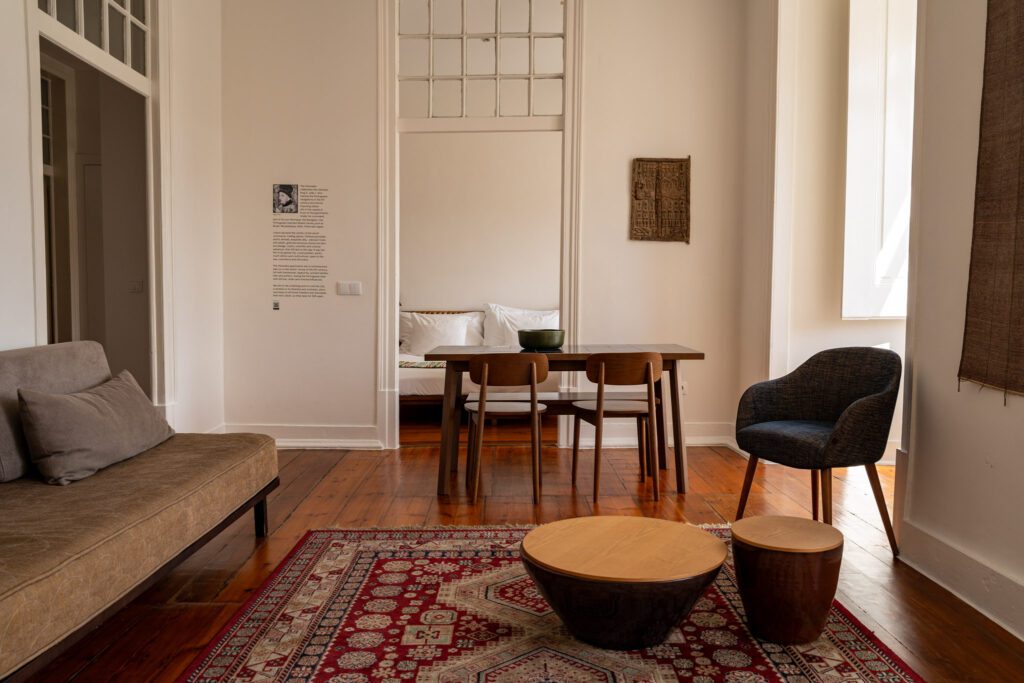
I (Matt) stayed there for the better part of a week on his latest trip to Lisbon and loved the central location, and the rooms are beautiful and spacious, with plenty of space to relax, do some writing, and cook a few meals at home.
Second is the place my mom stayed in when she went to Lisbon a few years ago.
Unsurprisingly, she used a lot of our guides to help her plan her trip. I ended up helping her pick a place to stay – an aparthotel called 54 São Paulo – which she absolutely loved.
In fact, here’s a direct quote from her about her trip: “Hands down the best place we stayed in Portugal!”
It’s an aparthotel, which basically means it has all the amenities of a hotel (like a staffed front desk), but the benefits of having an apartment (like a kitchen and more space to spread out).
They stayed in the “penthouse” with a private terrace and loved it.
Chiado: Our Top Recommendation for First Timers
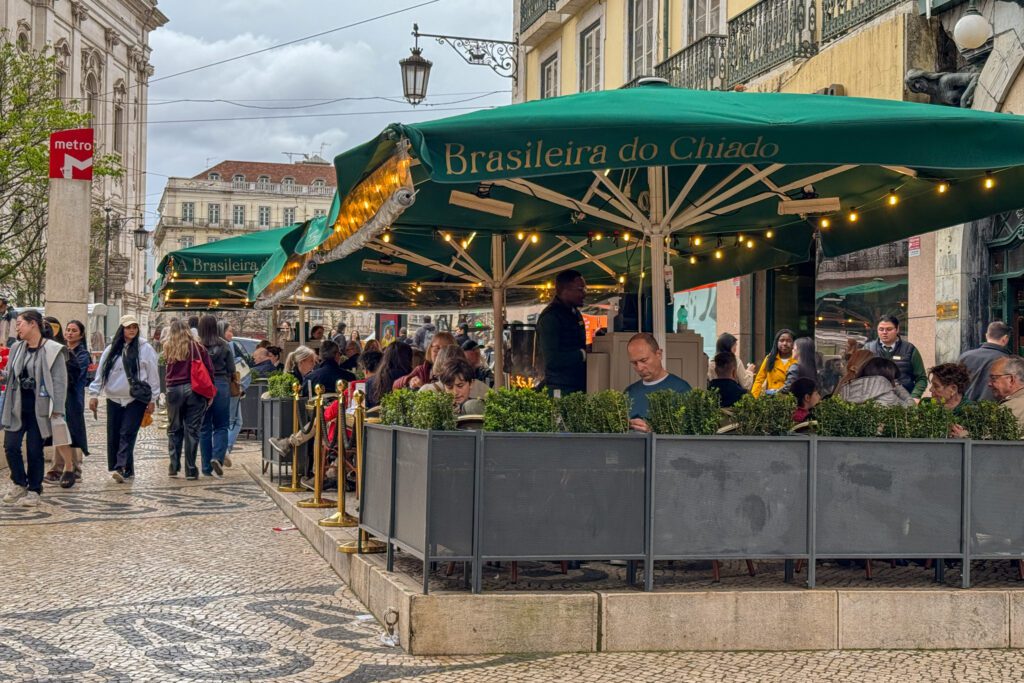
Chiado is our top pick because it blends the convenience that we love about Baixa with the charm of places like Alfama and Bairro Alto (which is adjacent to Chiado) to create an ideal place to stay if it’s your first time in Lisbon.
Chiado is the neighborhood that sits roughly halfway up the hill that culminates in Bairro Alto, which is on the west side of Baixa (Lisbon’s downtown area with modern planning).
Why do we enjoy Chiado and recommend it, you ask? Several reasons, all of which are positives.
Here’s how we’d sum it up:
It’s just about as central as it gets with easy access to Bairro Alto, Baixa, Rossio Station (to catch any trains), the metro, and the tram lines.
The only neighborhood that comes close is Baixa, and we think Chiado is much more charming than Baixa.
The obvious downside here is that, with all of that centrality and connectivity come crowds of visitors.
The area near the Elevador de Santa Justa in particular tends to be very crowded. But as you leave the main couple of squares and the area near the mall, it gets a lot quieter.
If you’re in Lisbon for a few days and looking for a central home base for exploring the entirety of the city, you really can’t go wrong with staying in Chiado.
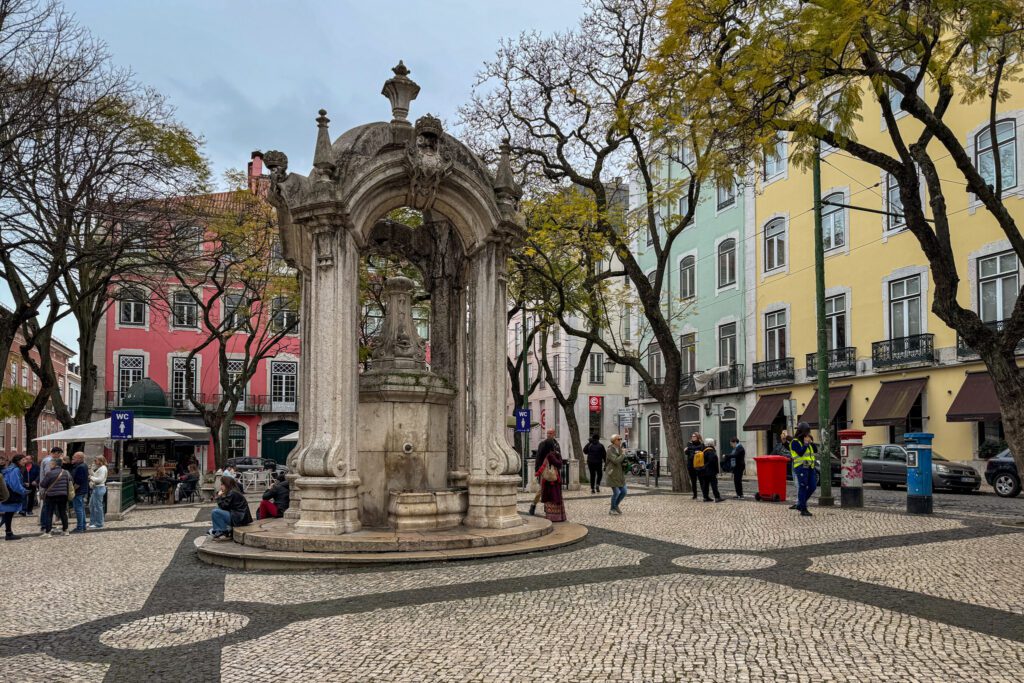
Pros and Cons of Staying in Chiado
Here are the pros and cons of staying in Chiado as we see them.
Pros of Staying in Chiado
It’s central and well connected. It’s walkable to Baixa, Bairro Alto, and Rossio Station (where you’ll catch the train to Sintra or other cities in Portugal). There’s a metro station right in the middle of the neighborhood, and there are great tram and bus connections to get to other parts of the city.
It’s charming. More charming than Baixa, less charming than Bairro Alto or Alfama, but of the more convenient areas (basically Chiado and Baixa), it’s by far our favorite.
There are plenty of hotel options. Unlike Bairro Alto and Alfama, which are more residential and where there are just a handful of hotel options, Chiado has plenty to choose from across a range of budgets.
Cons of Staying in Chiado
It’s full of tourists. Along with Baixa, Chiado sees some of the highest numbers of visitors. This is especially true near the elevator and mall on the border with Baixa, and the crowds tend to dissipate the further uphill you go.
The Best Places to Stay in Chiado
Here are some of the best places to stay in Chiado, whether you’re looking for a charming hotel or a spacious apartment where you have a bit more room to spread out and relax.
There’s a lot of options in Chiado, so we’ve gone ahead and combed through hundreds of places to stay to narrow the list down to a few options that we’re excited about based on style, reviews, and location.
Feeling Chiado 15: A Boutique Hotel in A Great Location
This charming hotel is right on the square where you’ll find the Convento do Carmo, which might be one of Lisbon’s single best locations.
From there, you’ll be a block away from the heart of Chiado, and within walking distance of Barrio Alto, Principe Real, and Baixa.
Comfortable, spacious rooms are the name of the game here.
Even the standard suites are larger than most hotel rooms you’ll find, but the deluxe suites are even bigger, some of which have a nice terrace with spectacular views of the city.
Chiado 44: A Mid-Range Guesthouse
This lovely guesthouse is a few blocks from the Baixa-Chiado metro station, which means you’ll be well-connected to the rest of the city if you decide to stay here.
The building itself dates back to the 19th Century, but the interior has been fully renovated with beautiful, stylish rooms and common spaces.
Once again, this isn’t your average mega-hotel chain. There are only 12 rooms here, which means you’re going to get personalized service.
Half of the rooms have river views and balconies, while the other half face the property’s garden (and two of those have balconies). Rooms are relatively small, but plenty comfortable if you’re planning on spending most of your time out and about exploring Lisbon.
Lost Lisbon – Chiado House: A Budget-Friendly Option
This guesthouse was on our list, but the timing and dates didn’t quite work out.
This is another intimate place to stay in Lisbon, with just a few rooms, exceptionally friendly service, and a beautifully decorated interior.
Your room comes with a continental breakfast, and you’ll have access to the shared kitchen to cook lunch or dinner, if you wish to. Which makes this a cross between a hostel and a hotel.
They have smaller rooms outfitted with a pair of twin beds, and larger rooms that have a comfy double bed.
The decor is impeccably stylish – we love the blue tile accents throughout – and it’s worth noting that some of the rooms have private external bathrooms (rather than bathrooms inside the rooms).
The same company also has a location on Avenida da Liberdade (see it here), which is also a nice location (though not quite as central to Lisbon’s major sights).
Casa do Barao: A Nice Boutique Hotel with a Pool
I mean, this boutique hotel is in a 19th Century building that oozes charm, has a library room, and has a great outdoor pool. Plus, it’s in one of the best areas in our favorite district in Lisbon, just a short walk away from all of the action.
Unfortunately, we didn’t know about this place on our first trip, and when we went to try to book it for our return trip, they were renovating the building. So staying here didn’t quite work out for us, but that shouldn’t stop you!
It’s a hotel with just 12 rooms, so it’s more of a bed & breakfast when it comes to the service you’ll get (versus the mega hotels with 100+ rooms).
The idea of a smaller, intimate hotel as a contrast to the massive hotel chains is exactly what got the owners into the hotel business in the first place.
As far as rooms go, they have a range for different budgets, from their smaller (but still pretty spacious) standard rooms to their huge premium rooms with terraces.
Breakfast is served on their lovely garden patio. And did we mention the pool?
Baixa: The Most Convenient Place to Stay
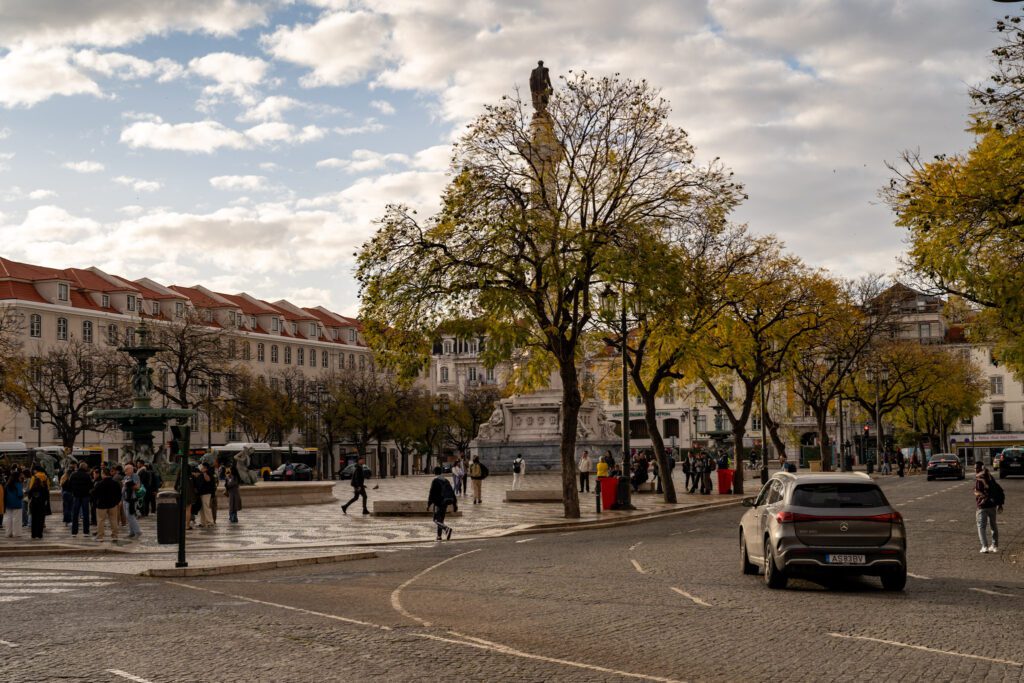
As I’m sitting here in my apartment in Baixa, I am just now realizing that despite my strong desire to stay elsewhere, I’ve stayed in Baixa on three consecutive trips to Lisbon.
The reason? The convenience is truly unbeatable.
Baixa is the gridded “downtown” neighborhood that sits in the valley between Lisbon’s two big hills, and it’s the part of the city that was essentially completely destroyed during the 1755 earthquake and subsequent tsunami.
Because it was re-planned in the 18th Century, you tend to see more modern urban planning in this part of the city, with a grid system and some pedestrianized streets, which makes it easier to get around and navigate.
While other neighborhoods are certainly a little more lively and interesting, there’s no other neighborhood that puts you within an easy walk of the two hills – the hill where you’ll find Alfama and Graça (along with our favorite view in Lisbon) and the hill where you’ll find Chiado and Bairro Alto – along with both of the most useful metro lines AND the train to Sintra or Cascais.
It’s impossible to beat that convenience, and as long as you’re prepared to spend the majority of your time in other parts of the city where you’ll find better food and drinks, it’s a perfect home base (especially for a relatively short trip).
All that being said, I do think there’s a particular part of Baixa that stands out as somewhat better than others, and that’s the area around Rossio and Figuera squares, which are adjacent and form the backbone of the most charming piece of the neighborhood (and also put you in the best position to take advantage of the convenience).
Overall, it’s a great place to stay, though we would recommend that you spend most of your day outside of Baixa exploring the less touristy and, frankly, more interesting parts of Lisbon.
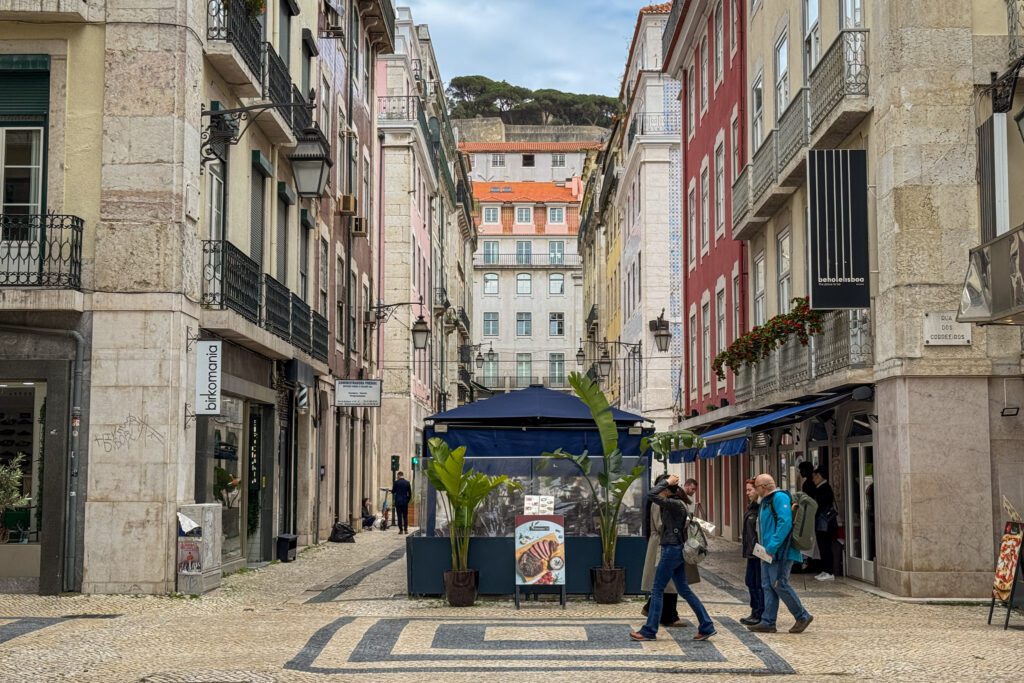
Pros and Cons of Staying in Baixa
Here are the pros and cons of staying in Baixa as we see them.
Pros of Staying in Baixa
The convenience is unbeatable. As I covered above, staying here means you’re within walking distance of basically everything in central Lisbon, and an easy transit ride from almost everything else.
Good transit connections. With multiple metro lines (green and blue) and the regional trains at Rossio, you can basically go anywhere you need to without too many connections.
Plenty of hotels to choose from. Since this neighborhood tends to cater to visitors, you have a plethora of hotels to choose from across a range of budgets.
Cons of Staying in Baixa
It’s not the most lively. During the day, it’s bustling with a combination of visitors and people dispersing from the metro and train stations. At night, there’s not a whole lot going on (aside from Cais do Sodre, which I’d personally recommend avoiding).
It can feel “touristy” in parts. While I generally hate the word “touristy”, I think it’s useful to consider what that word actually means. To me in this context, it’s about a neighborhood whose businesses cater to visitors rather than people that live there, with Instagrammable brunch spots and shops selling souvenirs. For the most part, that’s what you’re going to find in Baixa.
The Best Places to Stay in Baixa
Baixa has a nice mix of places to stay, mostly hotels and apartments, with a few hostels thrown in, which are perfect if you’re heading to Lisbon on a tight budget.
We went through the choices and narrowed it down to these four, which we really like.
My Story Hotel Figueira: A Stylish Boutique Hotel
We walked by this charming hotel a couple of times over the course of our time in Lisbon, and every time I turned to Alysha and said something to the effect of “I need to check that place out.”
This is a Portuguese hotel chain with locations in Lisbon, Porto, and the Azores, and all of their hotels are gorgeous.
The hotel is right on Figueira Square, which is basically adjacent to Rossio Square in the heart of Baixa, central to Alfama, Chiado, the Rossio Train Station, and more.
The colorful rooms are relatively spacious (over 200 square feet!), and beds are rated as very comfortable. Some rooms have a view out onto the square (which we’d imagine comes with a little bit more noise).
They have a 24 hour reception who are happy to help you with whatever you might need, breakfast, and there’s an Italian restaurant on the ground floor.
Be Poet Baixa: A Modern Mid-Range Hotel + Great Location
The location of this modern hotel is just about perfect, roughly equidistant between Alfama, Rossio Train Station, and Praça do Comércio.
With that location, you’ll be able to walk or take public transportation to basically anywhere in Lisbon or beyond.
Rooms here aren’t the biggest, but they’re going to be both comfortable and affordable, which is definitely a tradeoff we’re willing to make.
Decor is very modern, lacking some of the charm of older buildings that we kind of like about Lisbon, but that’s just our opinion.
Rooms are outfitted with coffee makers and reviews consistently call out the beds as super comfortable, which makes this place an excellent home base for exploring Lisbon.
Casas da Baixa Jules & Madeleine: Spacious Serviced Apartments
This collection of spacious apartments is right down the street from Porta Do Mar, which means we know firsthand that it’s a solid place to stay.
The serviced apartments here – which are a cross between a hotel and an apartment building, giving you the best of both worlds – have a range of different sizes. Studios for traveling couples or pairs of friends, all the way up to two bedroom apartments with room for five.
The building is a restored 18th Century building, and the interior of the apartments are a mix of that historic character and more modern design and appliances. Rooms have small, but totally functional, kitchens, if doing some cooking is something you’re into (we are!).
They have another set of apartments – Casas da Baixa Lighthouse – just around the corner, if your dates don’t work for the other apartments.
Home Lisbon Hostel: A Family-Run, Intimate Boutique Hostel
Home Lisbon Hostel is right in the heart of Baixa, a few blocks away from the Lisbon Cathedral and the path up to Alfama, and a few blocks away from the Elevador de Santa Justa, which takes you up to Chiado.
It’s a family-run joint, which is part of the reason we picked it, which you know because they have something called “Mamma’s Dinner” where the mother of the hostel’s owner cooks a dinner full of Portuguese classics.
It’s small, at least relative to some of the other hostels in Lisbon, but we think that’s part of the charm and often leads to a better, more personal and intimate experience.
They have both private rooms and dorms (max 8 people per room) available.
The private rooms are cozy and well-decorated (I love the rooms with the rich green walls and dark brown furniture), and they’re basically hotel rooms. Some even have a balcony with city views!
Alfama: The Most Romantic Neighborhood in Lisbon
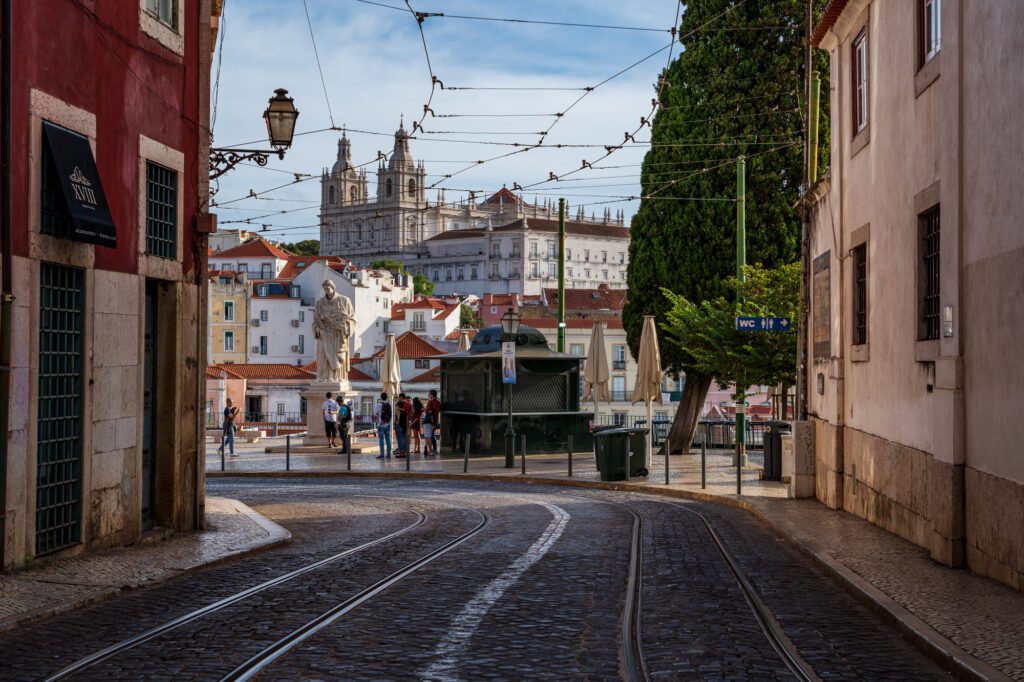
Alfama is the most romantic slice of central Lisbon, with its narrow winding streets and excellent views from around nearly every corner.
Lisbon is very much a city that’s made for wandering, and there is no better neighborhood to get lost in than Alfama.
It’s also one of the oldest parts of the city, evidenced by the presence of a Roman amphitheater that has been uncovered under the modern streets (which you can see today).
The castle that’s visible from the lowlands – Castelo de São Jorge – sits at the top of the neighborhood (though there are better views to be had from a short walk up the hill!), and has served many purposes over the 18 or so centuries that the fortifications have existed here.

It’s a good illustration of Lisbon’s history because every Mediterranean power that has occupied this land – from the Phoenicians, Carthaginians, and Romans, to the Islamic Caliphate that existed in southern Portugal for centuries and the present day Portuguese – set up shop here at the top of the hill.
It is worth noting, though, that the castle fell into disrepair after the earthquake in 1755 and was only restored in the 20th Century under the dictatorship as a symbol of the golden age.
Anyway, all that is to say that Alfama is well worth a half day or so of your time, but the question of whether you should stay there is a bit more complicated.
It’s charming. It’s romantic. It’s a fun place to eat and drink (especially if you include nearly Graça, which is a great place to both wander and eat).
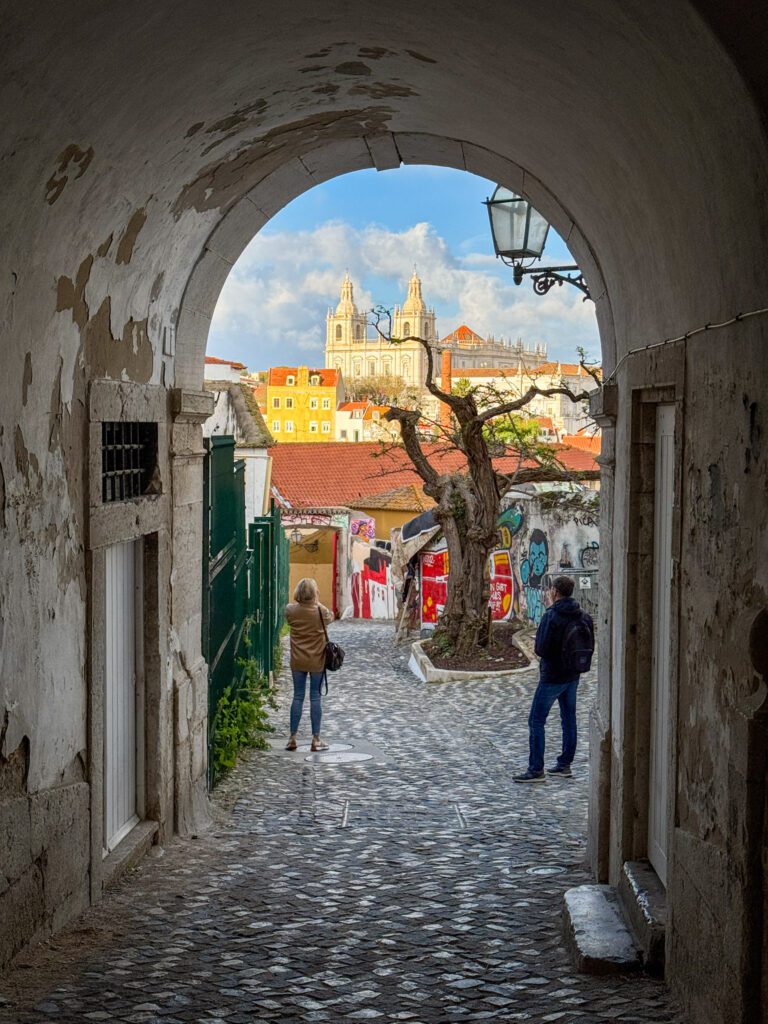
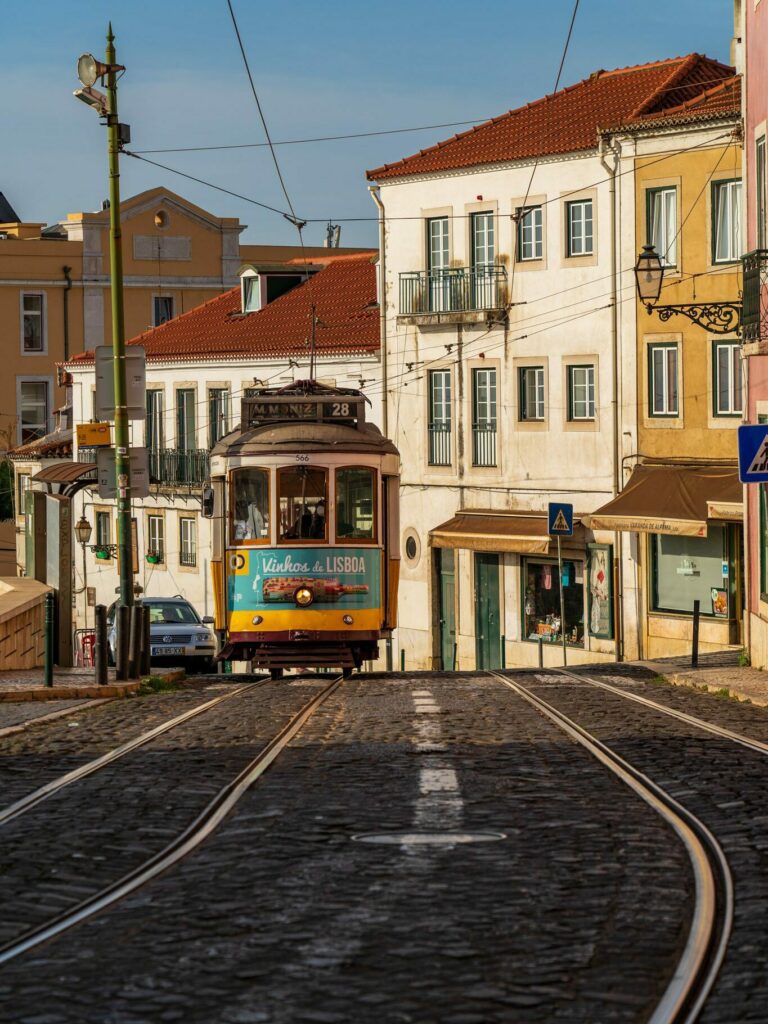
But the big challenge here is that Alfama is fairly difficult to access thanks to the pedestrian-only streets that sprawl down the hill towards the water and the fact that it’s on top of a hill.
Being at the top of the hill also means that it’s not particularly well-connected to the rest of the city via public transit.
The famous tram 28 runs right through the heart of Alfama, but it’s also true that the 28 is incredibly busy with tourists from about 10am to 8pm, and is probably not a great option for that reason.
The last point I want to make is that Alfama is relatively expensive because there are really only a handful of hotels here (and you shouldn’t stay in an Airbnb here, we think).
Whether those cons, which are fairly significant, outweigh the charm is ultimately up to you, but for us, we’d probably opt to stay somewhere more central and convenient to the rest of the city.
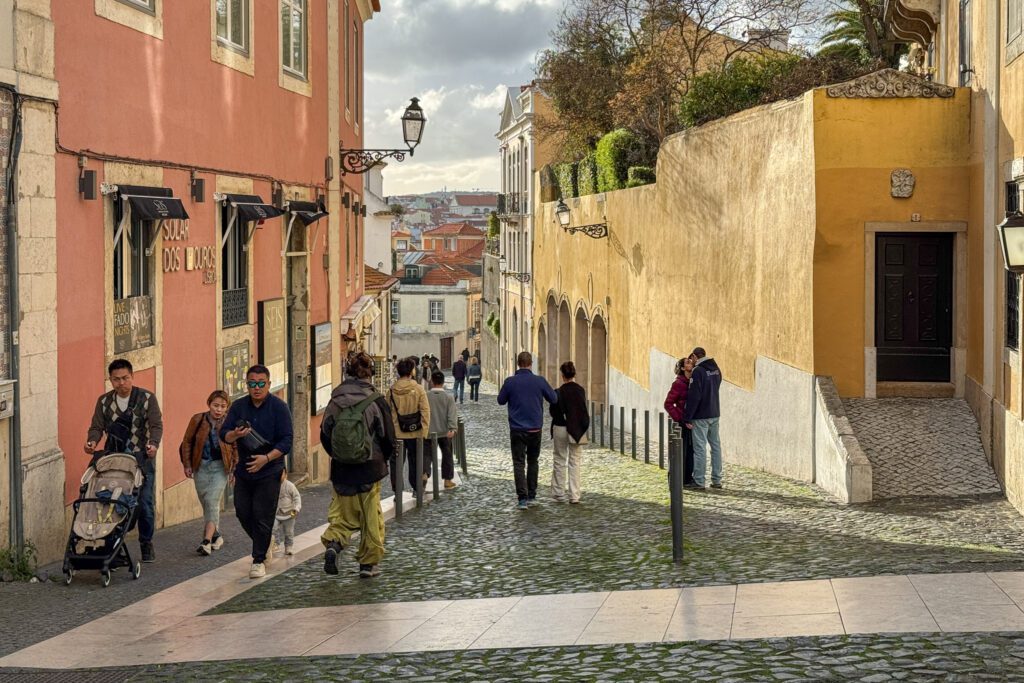
Pros and Cons of Staying in Alfama
Here are the pros and cons of staying in Alfama as we see them.
Pros of Staying in Alfama
It’s sexy. There’s something about narrow alleyways masquerading as streets and walking on cobblestones that has a certain romance, and Alfama is chock full of it.
It has great views. There are several fantastic viewpoints where you can look out over Lisbon (views are particularly good in the evening). The further up the hill you go, the better they get.
It’s an excellent place to eat and drink. There are plenty of great bars and restaurants to be had, particularly on the northeast side of the castle.
Cons of Staying in Alfama
It’s not central or convenient. It’s pretty easily the hardest place to access in Lisbon. Wherever you’re going, you’re likely going to either have to walk up or down a hill, or hop on the Tram 28 which is notoriously packed with tourists between 10am and 8pm or so.
Parts are hard to access by car. If you try to take a taxi or Uber, good luck having them navigate those narrow streets. Again, you’re going to be walking. If walking isn’t your thing, we’d look elsewhere and plan on visiting Alfama for an evening instead. It’s also going to be fairly expensive since it’s a desirable place to stay, and there aren’t a ton of options.
There’s another con that we think is worth touching on here, and that’s gentrification.
As Alfama (and Lisbon as a whole) finds itself firmly on the tourist map, more and more of the historic buildings in the area are being bought up to turn into hotels and apartments catering to the tourist demand.
Which means less inventory for locals, and higher prices, pushing people out of the homes that they’ve lived in for decades.
We’re not going to solve that problem here, but it’s worth considering as a factor when you make your decision about where to stay. Frankly, it’s a problem throughout the entirety of the city, but it’s most pronounced in Alfama.
The Best Places to Stay in Alfama
There are a bunch of places to stay in Alfama, from upscale hotels to cozy apartments.
Lucky for you, we’ve gone through and found (read: looked at all the pictures and read reviews until our eyes were glazed over) a collection of places with great reviews that we personally like and would recommend.
Alfama is full of winding, narrow streets, which can make getting to and from your hotel a little bit of a pain. However, what it may lack in convenience it more than makes up for in atmosphere.
Here are a couple of places to stay in Alfama that caught our eye.
Hotel Convento do Salvador: A Hotel in a Former Convent
Right around the corner from one of the best viewpoints in all of Lisbon – Miradouro das Portas do Sol – is this beautiful hotel with an excellent outdoor terrace and bar.
Despite the luxurious feel, the prices are actually relatively affordable, which surprised us.
The hotel itself is built into a former convent, and is located within walking distance of the castle, a couple of really nice viewpoints, and some great bars and restaurants (do not miss the canned fish at Miss Can!).
This is an eco-friendly hotel, and I particularly like that they bottle tap water into these fancy bottles to stop people buying tons of plastic water bottles over the course of their trip.
DRINK THE TAP WATER, it’s totally safe (we drank gallons of it, and we’re still here).
Rooms are relatively small, but well thought out with modern touches. You’ll have to pay a little extra for a view of the river Tejo from your room, but you can always just head out to the terrace if you’re craving a spectacular view.
Bairro Alto: Atop the Hill with Great Views
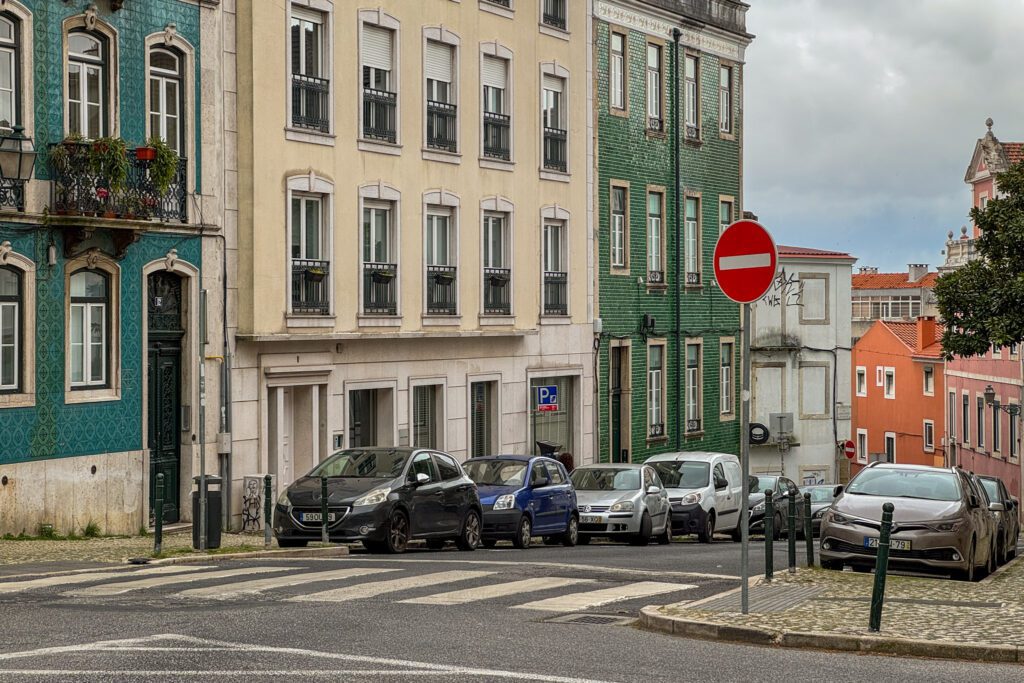
Perched at the top of the hill above Chiado, which means the views around every corner are pretty spectacular, you’ll find what has become my personal favorite neighborhood to explore; Bairro Alto. Which literally translates to “high neighborhood” (or something to that effect).
First of all, note the spelling (it’s “Bairro” not “Barrio” like it would be in Spanish).
Bairro Alto is immediately adjacent to Chiado, and has roots dating all the way back to the 16th Century, when the grid was first laid out and buildings started to be built.
This part of Lisbon saw fewer devastating effects from the earthquake than other parts of the city, but Pombal and the Portuguese government took the opportunity to strike when the iron was hot and modernize the infrastructure in Bairro Alto in the period where the rest of Lisbon was being rebuilt from the ground up.
Today, Bairro Alto is a nightlife hub, and is full of bars, clubs, and restaurants of all kinds.
Packed nearly wall to wall with tourists and locals alike who are enjoying their drinks in the middle of the street (at least in the warm and mild months…so, like, 10 months of the year?), Bairro Alto comes alive when the sun goes down.
From wine bars to speakeasy cocktail bars to nightclubs that don’t close until the early morning, you’ll find the best nightlife in the city here.
There are, of course, tradeoffs with being right in the middle of all the action.
It’s loud at night, so don’t expect to stick to your 9pm bedtime (honestly, that’s the only reason why we wouldn’t personally stay here – Matt needs his beauty sleep!).
Bairro Alto reminds me a little bit of Nob Hill, the neighborhood in San Francisco where Alysha and I met, fell in love, moved in together, and eventually left to bet it all on this project.
It’s on top of one of the city’s tallest hills, it has great views in every direction, it’s a mix of residents and visitors, and it’s full of great places to eat and drink.
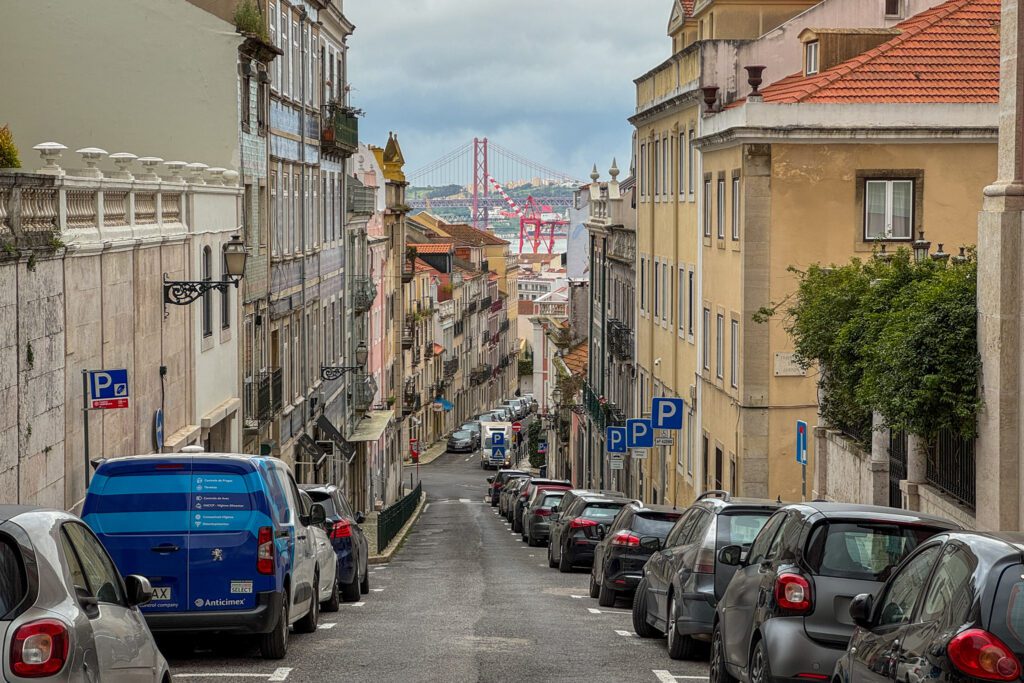
However, as you can probably imagine, it also happens to have several notable downsides that a neighborhood perched on top of a hill tends to have.
The two big ones are that it’s not great for people who aren’t into walking (or stairs) because it requires descending the hill to go anywhere (or access public transportation), and that it’s relatively expensive because everyone wants those views.
Another thing to consider – and your point of view will dictate whether you think this is a pro or a con – is that this is one of the nightlife hubs in Lisbon.
Walk through it at 1pm? Deserted. Walk through it at 1am? Certainly not deserted.
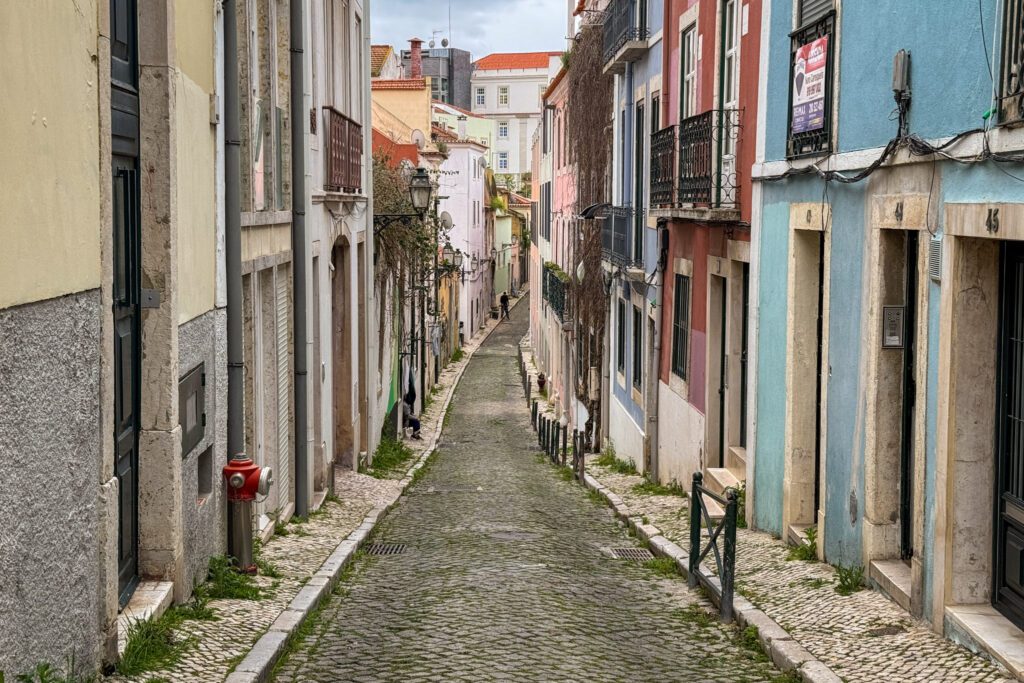
It’s not going to be the quietest neighborhood around, so if you value your sleep (like me) I’d probably look elsewhere.
There are literally signs around the neighborhood that beg people to be quiet for the sake of the locals.
Pros and Cons of Staying in Bairro Alto
Here are the pros and cons of staying in Bairro Alto as we see them.
Pros of Staying in Bairro Alto
It’s beautiful and charming. The neighborhood itself is beautiful, with tile-adorned buildings, some nice green spaces (we like Jardim do Príncipe Real), and the aforementioned incredible views around every corner.
It’s a nice mix of residents and visitors. Residents means that there are plenty of businesses that cater to people that actually live there (which means better restaurants, generally speaking). Visitors bring a certain energy that you don’t get in places that are more low key. A mix is ideal, we think.
Cons of Staying in Bairro Alto
It’s on top of the hill. Any way you slice it, you’re either going to be doing a lot of climbing (usually either on steep cobblestones or stairs) to go anywhere else in the city, or taking a lot of taxis or rideshares to get around. This includes accessing public transportation, which exists atop the hill, but many of the main routes are found at the base of the hill.
Connections from the airport aren’t great. Because transit connections are a little harder to come by in Bairro Alto, you’re probably going to want to take a taxi or rideshare (Uber and Bolt are the two main options in Lisbon) to get from the airport to your accommodations. Otherwise you’re looking at multiple connections, which can be a mess with luggage.
It’s expensive and there aren’t that many options. A neighborhood atop a hill that is mostly residential is a recipe for an expensive place to stay. And Bairro Alto fits the bill. Because there aren’t that many options here, you’re going to pay a premium to stay here.
Planning a trip to Portugal?
Here are our other Portugal travel guides to help you plan an incredible trip (even if you have to eat gluten free!).
If there’s no link below, it means we’re still working on it – long, in-depth guides take time! We’re working on it, though, we promise.
Portugal:
- Exactly How to Spend One Week in Portugal (for First Timers)
- 10 Days in Portugal: Planning the Perfect Portugal Itinerary
Lisbon
- 25 Incredible Things to Do in Lisbon: A Complete Guide
- 3 Days in Lisbon: Planning the Perfect Lisbon Itinerary
- One Day in Lisbon: The Best of Lisbon in 24 Hours
- Where to Stay in Lisbon: Our Guide to 4 Amazing Places to Stay
- Gluten Free Lisbon: A Complete Guide to Lisbon’s Best Gluten Free Restaurants
- The Best Coffee in Lisbon: 9 Amazing Lisbon Coffee Shops to Add to Your List
Porto:
- 3 Days in Porto: Planning the Perfect Porto Itinerary
- One Day in Porto: How to See the Best of Porto in a Day
- Where to Stay in Porto, Portugal: The 3 Best Places to Stay
The Algarve:

Such great detail and ideas. Will keep your list of gf handy when we travel to Portugal summer ‘24
Thanks Sheryl! Glad you found it helpful. Let us know as you get closer if you have any questions – always happy to help.